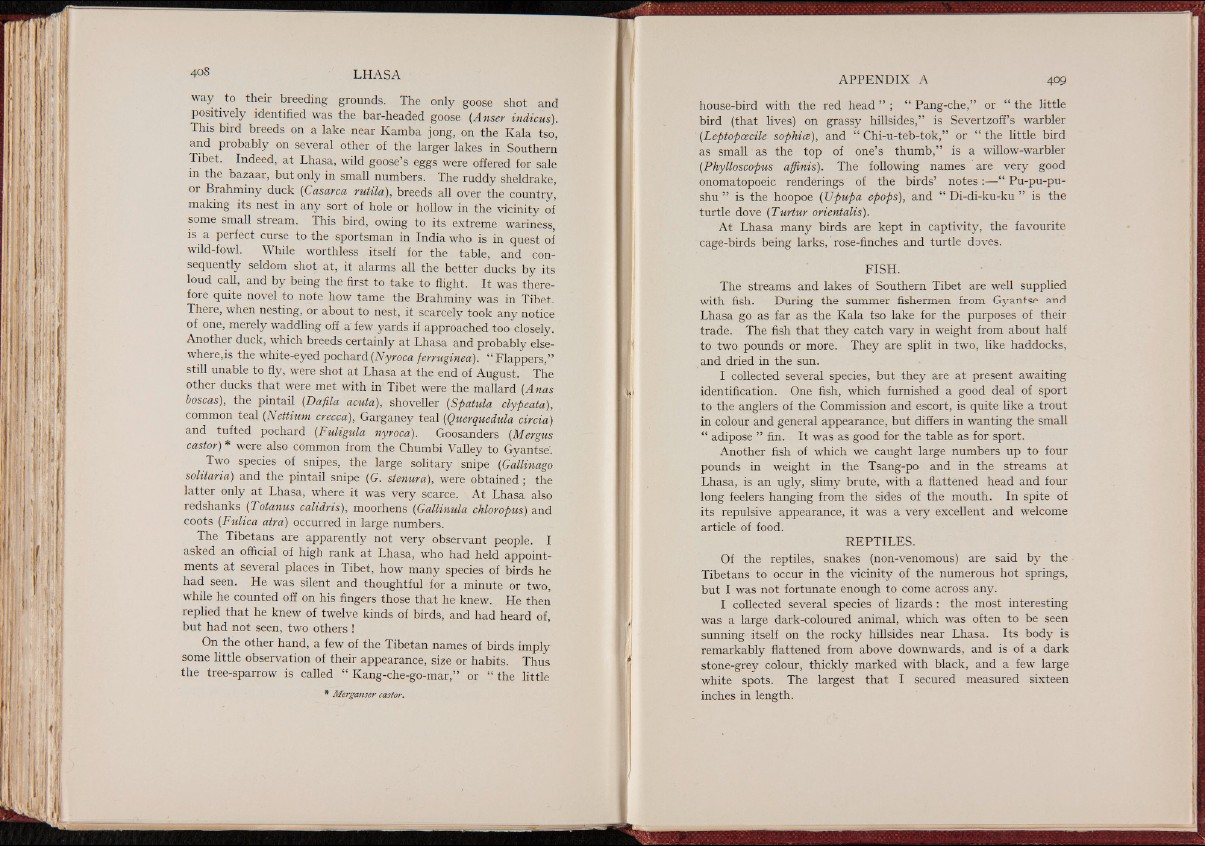
way to their breeding grounds. The only goose shot and
positively identified was the bar-headed goose (Anser indicus).
This bird breeds on a lake near Kamba jong, on the Kala tso,
and probably on several other of the larger lakes in Southern
Tibet. Indeed, at Lhasa, wild goose’s eggs were offered for sale
in the bazaar, but only in small numbers. The ruddy sheldrake,
or Brahminy duck (Casarca rutila), breeds all over the country,
making its nest in any sort of hole or hollow in the vicinity of
some small stream. This bird, owing to its extreme wariness,
is a perfect curse to the sportsman in India who is in quest of
wild-fowl. While worthless itself for the table, and consequently
seldom shot at, it alarms all the better ducks by its
loud call, and by being the first to take to flight. It was therefore
quite novel to note how tame the Brahminy was in Tibet.
There, when nesting, or about to nest, it scarcely took any notice
of one, merely waddling off a few yards if approached too closely. ’
Another duck, which breeds certainly at Lhasa and probably elsewhere,
is the white-eyed pochard (Nyyoca feyyuginea). “ Flappers,”
still unable to fly, were shot at Lhasa at the end of August. The
other ducks that were met with in Tibet were the mallard (Anas
boscas), the pintail (Dafila acuta), shoveller (Spatula clypeata),
common teal (Nettium cyecca), Garganey teal (Queyquedula ciycia)
and tufted pochard (Fuligula nyyoca). Goosanders (Meygus
castoy) were also common from the Chumbi Valley to Gvantse'.
Two species of snipes, the large solitary snipe (Gallinago
solitayia) and the pintail snipe (G. stenuya), were obtained ; the
latter only at Lhasa, where it was very scarce. At Lhasa also
redshanks (Totanus calidyis), moorhens (Galliyiula chloyopus) and
coots (Fulica atya) occurred in large numbers.
The Tibetans are apparently not very observant people. I
asked an official of high rank at Lhasa, who had held appointments
at several places in Tibet, how many species of birds he
had seen. He was silent and thoughtful for a minute or two,
while he counted off on his fingers those that he knew. He then
replied that he knew of twelve kinds of birds, and had heard of,
but had not seen, two others !
On the other hand, a few of the Tibetan names of birds imply
some little observation of their appearance, size or habits. Thus
the tree-sparrow is called “ Kang-che-go-mar,” or “ the little
* Merganser castor.
house-bird with the red head ” ; “ Pang-che,” or “ the little
bird (that fives) on grassy hillsides,” is Severtzoff’s warbler
(Leptopcecile sophice), and “ Chi-u-teb-tok,” or “ the little bird
as small as the top of one’s thumb,” is a willow-warbler
(Phylloscopus affinis). The following names are very good
onomatopoeic renderings of the birds’ notes:— “ Pu-pu-pu-
shu ” is the hoopoe (Upupa epops), and “ Di-di-ku-ku ” is the
turtle dove (Tuytuy oyientalis).
At Lhasa many birds are kept in captivity, the favourite
cage-birds being larks, rose-finches and turtle doves.
FISH.
The streams and lakes of Southern Tibet are well supplied
with fish. During the summer fishermen from Gyantse and
Lhasa go as far as the Kala tso lake for the purposes of their
trade. The fish that they catch vary in weight from about half
to two pounds or more. They are split in two, like haddocks,
and dried in the sun.
I collected several species, but they are at present awaiting
identification. One fish, which furnished a good deal of sport
to the anglers of the Commission and escort, is quite like a trout
in colour and general appearance, but differs in wanting the small
“ adipose ” fin. It was as good for the table as for sport.
Another fish of which we caught large numbers up to four
pounds in weight in the Tsang-po and in the streams at
Lhasa, is an ugly, slimy brute, with a flattened head and four
long feelers hanging from the sides of the mouth. In spite of
its repulsive appearance, it was a very excellent and welcome
article of food.
REPTILES.
Of the reptiles, snakes (non-venomous) are said by the
Tibetans to occur in the vicinity of the numerous hot springs,
but I was not fortunate enough to come across any.
I collected several species of lizards : the most interesting
was a large dark-coloured animal, which was often to be seen
sunning itself on the rocky hillsides near Lhasa. Its body is
remarkably flattened from above downwards, and is of a dark
stone-grey colour, thickly marked with black, and a few large
white spots. The largest that I secured measured sixteen
inches in length.